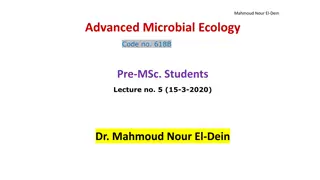Industrial Production of Ethyl Alcohol: Processes and Microorganisms
Ethyl alcohol production from molasses involves specific steps like selecting yeast strains, preparing inoculum, and creating fermentation conditions. Yeasts like Saccharomyces cerevisiae play a crucial role due to their alcohol tolerance and rapid growth properties. The process requires careful handling of yeast cultures to ensure successful fermentation of sugar into alcohol.
Download Presentation

Please find below an Image/Link to download the presentation.
The content on the website is provided AS IS for your information and personal use only. It may not be sold, licensed, or shared on other websites without obtaining consent from the author.If you encounter any issues during the download, it is possible that the publisher has removed the file from their server.
You are allowed to download the files provided on this website for personal or commercial use, subject to the condition that they are used lawfully. All files are the property of their respective owners.
The content on the website is provided AS IS for your information and personal use only. It may not be sold, licensed, or shared on other websites without obtaining consent from the author.
E N D
Presentation Transcript
Unit II Industrial Productions Mr. S. N. Mendhe Department of Microbiology, Shri Shivaji Science and Arts College, Chikhli
INDUSTRIAL PRODUCTION OF ETHYL ALCOHOL INDUSTRIAL PRODUCTION OF ETHYL ALCOHOL One of the most important and best known industrial fermentation is that in which ethyl alcohol is produced from sugar by yeast under anaerobic condition. The production of alcohol became commercially feasible on large scale shortly after the 1906 when industrial alcohol act was passed. This act allowed the sale of tax-free alcohol, if it was first denatured to prevent its use as alcoholic beverage. The unit of measurement commonly used in reporting the ethyl alcohol is the proof. Proof is twice the percent in the volume of ethyl alcohol. For example 95 % ethyl alcohol by volume is 190 proof.
INDUSTRIAL PRODUCTION OF ETHYL ALCOHOL FROM MOLASSES In India molasses factories) is the most important raw material used for alcohol production. The alcohol manufacturing process involves following steps. 1) Microorganism 2) Preparation of inoculum 3) Preparation of fermentation medium 4) Fermentation conditions 5) Recovery (obtained from sugar
1. MICROORGANISM Yeasts are the important organisms involved in alcohol production. Certain types of yeast properties are used A)Able to produce high concentration of alcohol. B)Having high alcohol tolerance C)Having uniform and characteristics. D)Capable of growing rapidly and vigorously in fermentation medium Selected strains of Saccharomyces cerevisiae are most commonly used. However, other yeast like Schizosaccharomyces anamensis, Candida yeast may also be used under certain conditions. possessing following stable biochemical pombe, Saccharomyces
2. PREPARATION OF INOCULUM (YEAST CULTURE) Large amount of yeast culture is required in industrial production of ethyl alcohol. The average amount of inoculum fermentation medium is 4 % volume-by-volume. The medium used for inoculum preparation is same as that of actual fermentation medium. Aeration is of benefit in preparing the inoculum, as the purpose is to obtain large no. of yeast cells. Steps involved in building up of inoculum are A)10 ml of sterile medium in a test tube is inoculated with pure culture of yeast and tube incubated at 28 to 300C for a suitable period. used for inoculation of
B)The tube culture is transferred to a flask containing 200 ml of sterile medium. Flask is incubated at 28 to 300C to obtain sufficient cell mass. C)The flask culture is transferred to a suitable glass container containing about 4 lit of sterile medium and incubated at 28 to 300C. D)Finally this culture is used to inoculate a small tank containing about 10-40 gallons of sterile medium. After incubation, the inoculum is used to inoculate the fermentation medium in fermenter.
3) PREPARATION OF FERMENTATION MEDIUM- Black strap molasses is the principal source of alcohol. This is the syrup that is left after the recovery of crystalline sugar from the concentrated juice of sugar cane. It usually contains 48 to 55 % sugar, mainly sucrose. To prepare fermentation medium molasses are diluted to a sugar concentration 10 to 18 % (usually 12 %)by adding required quantity of water. Higher sugar concentration adversely reacts on yeast and alcohol produced may inhibit the action of yeast with consequences that fermentation time is prolonged. The use of low concentration of sugar is uneconomic.
Molasses generally contain most of the nutrient substances for yeast but ammonium sulphate or phosphates may be added to the fermentation medium to supply deficiencies of nitrogen and phosphorus. The pH of the fermentation medium is adjusted to 4.8 to 5.5 by using H2SO4or lactic acid. Lactic acid bacteria can also adjustment. Due to acidic pH, medium usually does not get contaminated by bacteria. Therefore, usually fermentation medium however, pasteurization of fermentation medium may be practiced. be grown for pH is not sterilized but
4) FERMENTATION CONDITIONS - Following fermentation conditions are carefully controlled to obtain maximum yield. Temperature-An optimum temp of 28-300C is maintained. Temp increases due to heat generation during fermentation. This is controlled by circulating the water through cooling coils. At a temp above 300C alcohol evaporates rapidly and also favors the growth of bacterial contaminants. pH Fermentation proceeds satisfactorily at pH 4.0 to 4.5. This pH favors the growth of yeast and inhibits the growth of bacteria. Higher pH values increases contamination while lower pH values inhibits alcohol production. the chances of
H2SO4is commonly used to adjust the pH of mash. Lactic acid is also satisfactory. Lactic acid favors the growth of yeast but inhibits the growth of butyric acid bacteria, which is harmful to the yeast fermentation. Agitation and Aeration-Intermittent agitation is required for mixing and cooling the medium. Aeration is required only fermentation for optimum reproduction of yeast cells but it is not required for the production of alcohol. During fermentation, CO2 conditions are maintained. Fermentation time - Fermentation starts within few hours after the addition of yeast. in early stages of is evolved and anaerobic
RECOVERY RECOVERY The fermented mash (also called distilled to separate the ethyl alcohol and Fusel oils from the other constituents of the medium. During distillation, fractions containing different concentrations of alcohol are separated. The solids called slops or stillage recovered during distillation process are used as fertilizer constituent as they contain potassium and phosphates. Other byproducts of fermentation called fusel oil are also separated during distillation process. The alcohol obtained may be further purified, dehydrated and denatured. beer ) is
Fig. 2.1 Industrial Production of Ethyl Alcohol from Molasses
BY-PRODUCTS OF ALCOHOLIC FERMENTATION:- There are four main by-products of alcohol industry. These are A) CO2 B) Yeast C) Fusel oils D) Slops or Stillage A) CO2- CO2 is produced in large quantities during fermentation. It is collected and purified. Purified CO2 can be liquefied or converted into dry ice. Large quantities of liquefied CO2 are used in the soft drink industry for the manufacture of cold drinks, while dry ice has many commercial applications. B)Yeast- The yeast separated from fermented medium can be safely used for feeding the animals (animal feed). Thus this yeast is the valuable fodder, which is rich in proteins, vitamins and essential trace elements.
C) Fusel oils During fermentation, some quantities of higher alcohols mainly isoamyl alcohol and butyl alcohol is formed. This fraction of higher alcohols is collectively known as fusel oils. After refining they are used in the manufacture of perfumes and potable liquors. However the bulk amount of this fraction is converted into various acetates by esterification. Esters of these higher alcohols are used in paint industry and lacquer industry.
D) Slops- During distillation process slops are separated. The slops are usually discarded but may be used in no. of ways. The slops may be used as substitute for some of the water in diluting molasses for a new mash. The solids from the slops may be concentrated and sold as a fertilizer constituent as they contain potassium and phosphates. MECHANISM OF ALCOHOL FERMENTATION MECHANISM OF ALCOHOL FERMENTATION Alcohol fermentation is an anaerobic fermentation taking place in the absence of air or oxygen .The raw materials like molasses and waste sulphite liquor serves as the energy and carbon source for ethanol producing micro-organisms.
Monosaccharides fermented to alcohol while disaccharides are first hydrolysed to monosaccharides and are then fermented to form alcohol and CO2 as shown in the following reaction. Disaccharide -----C6H12O6 ------- 2 CH3CH2OH + 2CO2 Monosaccharide Monosaccharide (e.g. Glucose) is converted into pyruvic acid via glycolysis or EMP pathway. Pyruvic acid then acted upon by pyruvate decarboxylase and is converted into acetaldehyde and carbon dioxide. Acetaldehyde is then converted into ethyl alcohol by the enzyme alcohol dehydrogenase as shown below. (e.g.,Glucose) are directly Ethyl alcohol
INDUSTRIAL PRODUCTION OF ETHYL ALCOHOL INDUSTRIAL PRODUCTION OF ETHYL ALCOHOL FROM WASTE SULPHITE LIQUOR FROM WASTE SULPHITE LIQUOR Sulphite liquor is produced as a waste product in the manufacture of pulp from wood and is described separately in unit no.1 Fermentation process involves following steps. 1. MICROORGANISM -- Sulphite liquor fermentation utilizes yeast Candida pseudotrophicalis because of the ability of this organism to ferment pentose sugars. Although the Saccharomyces cerevisiae can also be used, but in this case the pentose sugars of the sulphite liquor are not fermented.
2. RAW MATERIAL Sulphite liquor, the waste product of paper pulping industry is the fundamental raw material in this process. 3. PREPARATION OF FERMENTATION MEDIUM Waste sulphite liquor obtained during pulping process cannot be used directly for fermentation as it contains SO2, which is toxic to the growth of yeast. Therefore, it is necessary first to remove SO2, acetic acid and formic acid that are present in liquor. Sulphite liquor is pumped into a column known as stripper where it flows top to bottom. Simultaneously, steam is introduced at the bottom of column and flows upward. This removes sulphur dioxide (SO2) and other volatile materials. This process is called conditioning of liquor.
The hot sulphite liquor is cooled to 30OC. A slurry (solution) of lime is added to adjust the pH to 4.5. Urea is also added to liquor as a source of nitrogen. 4 . FERMENTATION CONDITIONS The conditioned sulphite liquor is pumped into the fermentation tank. It is inoculated with yeast culture and following fermentation conditions are maintained to obtain maximum yield. pH- Fermentation is carried out at an optimum pH 4.5. Temp- Fermentation is carried out at an optimum temp of 30OC. Agitation & Aeration- The medium is intermittently agitated. No aeration is required as alcohol production takes place under anaerobic conditions .
Time- Fermentation process usually completes within 20 hrs. Yield The yield is about 22 gallons of alcohol per ton of pulp. 5. RECOVERY The alcohol is recovered from fermented mash as that of alcohol from molasses.
CO2 H2SO4 Water Molasses Storage tank Adjustment Fermentor Tank/ diluter Sugar content 10 18% pH 4.0 4.5 pH 4.0 4.5F. Time-50 hrs Additional Nutrients Temp.70-800F Vapours of alcohol & steam Beer Still Inoculom preparation Steam DistilleryWaste (Slops) Vaporizer Condenser Oil PurifyingRectifying column column Waste Alcohol Fusel























